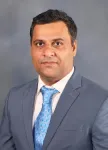(Press-News.org) Content warning: This post contains details of sharing intimate imagery without consent that may be disturbing to some readers.
While much attention on sexually explicit “deepfakes” has focused on celebrities, these non-consensual sexual images and videos generated with artificial intelligence harm people both in and out of the limelight. As text-to-image AI models grow more sophisticated and easier to use, the volume of such content is only increasing. The escalating problem led Google to announce last week that it will work to filter out these deepfakes in search results, and the Senate recently passed a bill allowing victims to seek legal damages from deepfake creators.
Given this rising attention, researchers at the University of Washington and Georgetown University wanted to better understand public opinions about the creation and dissemination of what they call “synthetic media.” In a survey, 315 people largely found creating and sharing synthetic media unacceptable. But far fewer responses strongly opposed seeking out these media — even when they portrayed sexual acts.
Yet previous research has shown that other people viewing image-based abuse, such as nudes shared without consent, harms the victims significantly. And in nearly all states, including Washington, creating and sharing such nonconsensual content is a crime.
“Centering consent in conversations about synthetic media, particularly intimate imagery, is key as we look for ways to reduce its harms — whether that’s through technology, public messaging or policy,” said lead author Natalie Grace Brigham, who was a UW master's student in the Paul G. Allen School of Computer Science & Engineering while completing this research. “In a synthetic nude, it’s not the subject’s body — as we’ve typically considered it — that’s being shared. So we need to expand our norms and ideas about consent and privacy to account for this new technology.”
The researchers will present their findings Aug. 13 at the 20th Symposium on Usable Privacy and Security in Philadelphia.
“In some sense, we’re at a new frontier in how people’s rights to privacy are being violated,” said co-senior author Tadayoshi Kohno, a UW professor in the Allen School. “These images are synthetic, but they still are of the likeness of real people, so seeking them out and viewing them is harmful for those people.”
The survey, which the researchers conducted online through Prolific, a site that pays people to respond on a variety of topics, asked U.S. respondents to read vignettes about synthetic media. The team altered variables in these scenarios like who created the synthetic media (an intimate partner, a stranger), why they created it (for harm, entertainment or sexual pleasure), and what action was shown (the subject performing a sexual act, playing a sport or speaking).
The respondents then ranked various actions around the scenarios — creating the video, sharing in different ways, seeking it out — from “totally unacceptable” to “totally acceptable” and explained their responses in a sentence or two. Finally, they filled out surveys on consent and demographic information. The respondents were over the age of 18 and were 50% women, 48% men, 2% non-binary and 1% agender.
Overall, respondents found creating and sharing synthetic media unacceptable. Their median totally unacceptable or somewhat unacceptable ratings were 90% for creating these media and 94% for sharing them. But the median of unacceptable ratings for seeking out synthetic media was only 53%.
Men were more likely than respondents of other genders to find creating and sharing synthetic media acceptable, while respondents who had favorable views of sexual consent were more likely to find these actions unacceptable.
“There has been a lot of policy talk about preventing synthetic nudes from getting created. But we don't have good technical tools to do that, and we need to simultaneously protect consensual use cases,” said co-senior author Elissa M. Redmiles, an assistant professor of computer science at Georgetown University. “Instead, we need to change social norms. So we need things like deterrence messaging on searches — we’ve seen that be effective at reducing the viewing of child sexual abuse images — and consent-based education in schools focused on this content.”
Respondents found scenarios in which intimate partners created synthetic media of people playing sports or speaking for the intent of entertainment the most acceptable. Conversely, nearly all respondents found it totally unacceptable to create and share sexual deepfakes of intimate partners with the intent of harm.
Respondents’ reasoning varied. Some found synthetic media unacceptable only if the outcome was harmful. For example, one respondent wrote, “It’s not harming me or blackmailing me… [a]s long as it doesn’t get shared I think it’s okay.” Others, though, centered their right to privacy and right to consent. “I feel it’s unacceptable to manipulate my image in such a way — my body and how it looks belongs to me,” wrote another.
The researchers note that future work in this space should explore the prevalence of non-consensual synthetic media, the pipelines for how it’s created and shared, and different methods to deter people from creating, sharing and seeking out non-consensual synthetic media.
“Some people argue that AI tools for creating synthetic images will have benefits for society, like for the arts or human creativity,” said co-author Miranda Wei, a doctoral student in the Allen School. “However, we found that most people thought creating synthetic images of others in most cases was unacceptable — suggesting that we still have a lot more work to do when it comes to evaluating the impacts of new technologies and preventing harms.”
This research was funded in part by the National Science Foundation and the Google PhD Fellowship Program.
For more information, contact Brigham at nbrigham@uw.edu, Wei at weimf@cs.washington.edu, Kohno at yoshi@cs.washington.edu and Redmiles at elissa.redmiles@georgetown.edu.
END
Many survey respondents rated seeking out sexually explicit ‘deepfakes’ as more acceptable than creating or sharing them
2024-08-09
ELSE PRESS RELEASES FROM THIS DATE:
Strike Force: Utah State leads collaborative $2.3M NSF grant to study earthquake critical zones
2024-08-09
LOGAN, UTAH, USA -- Utah State University geoscientist Alexis Ault recalls the devastating aftermath of back-to-back 7.8 and 7.6-magnitude earthquakes on Feb. 6, 2023, near the Turkey-Syria border that killed more than 50,000 people and displaced millions.
“We witnessed the destruction firsthand, as well as the resilience of the country and population trying to get their footing and rebuild,” says Ault, associate professor in USU’s Department of Geosciences, who traveled to the disaster site about six months after ...
Achieving quantum memory in the hard X-ray range
2024-08-09
Light is an excellent carrier of information used not only for classical communication technologies but also increasingly for quantum applications such as quantum networking and computing. However, processing light signals is far more complex, compared to working with common electronic signals.
An international team of researchers including Dr. Olga Kocharovskaya, a distinguished professor in the Department of Physics and Astronomy at Texas A&M University, has demonstrated a novel way of storing and releasing X-ray pulses at the single photon level — a concept first ...
Study shows donor kidneys with toxoplasma do not increase risks for transplant patients
2024-08-09
A new study from UC Davis Health could help to increase the supply of donor kidneys.
Researchers have found that transplant patients who receive kidneys infected with the parasite toxoplasma have virtually the same outcomes as those who receive toxoplasma-negative organs.
Despite longstanding concerns, those who received kidneys from toxoplasma antibody positive donors (TPDs) had almost identical mortality and rejection rates. The research was published in Transplant International.
“Organs from donors who were positive for toxoplasma did ...
Advanced MRI scans help identify one in three concussion patients with ‘hidden disease’
2024-08-09
Offering patients with concussion a type of brain scan known as diffusion tensor imaging MRI could help identify the one in three people who will experience persistent symptoms that can be life changing, say Cambridge researchers.
Around one in 200 people in Europe every year will suffer concussion. In the UK, more than 1 million people attend Emergency Departments annually with a recent head injury. It is the most common form of brain injury worldwide.
When a patient in the UK presents at an Emergency Department with head injury, they ...
Psychological bias links good deeds to a belief in God, research says
2024-08-09
Experiments conducted by UC Merced researchers find that people who perform good deeds are far more likely to be thought of as religious believers than atheists. Moreover, the psychological bias linking kindness and helpfulness with faith appears to be global in scale.
Research on the mental link between moral behavior and religious belief goes back more than a decade. Prior research, however, emphasized the dark side of this equation, with participants asked whether they assumed it was more probable that a serial killer believed in God or was an atheist (people in nations all over the planet thought the latter ...
Greenland megatsunami led to week-long oscillating fjord wave
2024-08-09
In September 2023, a megatsunami in remote eastern Greenland sent seismic waves around the world, piquing the interest of the global research community.
The event created a week-long oscillating wave in Dickson Fjord, according to a new report in The Seismic Record.
Angela Carrillo-Ponce of GFZ German Research Centre for Geoscience and her colleagues identified two distinct signals in the seismic data from the event: one high-energy signal caused by the massive rockslide that generated the tsunami, and one very long-period (VLP) signal that lasted over a week.
Their analysis of the VLP signal—which was detected as far as 5000 kilometers away—suggests ...
Machine learning approach helps researchers design better gene-delivery vehicles for gene therapy
2024-08-08
Gene therapy could potentially cure genetic diseases but it remains a challenge to package and deliver new genes to specific cells safely and effectively. Existing methods of engineering one of the most commonly used gene-delivery vehicles, adeno-associated viruses (AAV), are often slow and inefficient.
Now, researchers at the Broad Institute of MIT and Harvard have developed a machine-learning approach that promises to speed up AAV engineering for gene therapy. The tool helps researchers engineer the protein shells of AAVs, called capsids, to have multiple desirable ...
Bacteria encode hidden genes outside their genome—do we?
2024-08-08
NEW YORK, NY (Aug. 8, 2024) -- Since the genetic code was first deciphered in the 1960s, our genes seemed like an open book. By reading and decoding our chromosomes as linear strings of letters, like sentences in a novel, we can identify the genes in our genome and learn why changes in a gene’s code affect health.
This linear rule of life was thought to govern all forms of life—from humans down to bacteria.
But a new study by Columbia researchers shows that bacteria break that rule and can create free-floating and ephemeral genes, raising the possibility that similar genes exist outside ...
Assistant professor's $1.1M NASA grant to develop computational tool aiding hypersonic vehicle design
2024-08-08
STARKVILLE, Miss.—NASA is awarding a Mississippi State University assistant professor a $1.13 million grant to develop a new simulation tool to aid the design of hypersonic vehicles used in space exploration.
Vilas Shinde of MSU’s Department of Aerospace Engineering won the grant to develop a new flow stability and transition analysis tool, which will aid researchers and aircraft designers in understanding and predicting changes associated with the boundary layer—air flow in the vicinity of an aircraft’s ...
Houston Methodist study shows new, more precise way to deliver medicine to the brain
2024-08-08
Houston Methodist researchers have discovered a more accurate and timely way to deliver life-saving drug therapies to the brain, laying the groundwork for more effective treatment of brain tumors and other neurological diseases.
In a study published this month in Communications Biology, an open access journal from Nature Portfolio, investigators used an electric field to infuse medicine from a reservoir outside the brain to specific targets inside the brain. This adds a new dimension to the 30-year-old process of injecting therapeutics into the brain through ...



